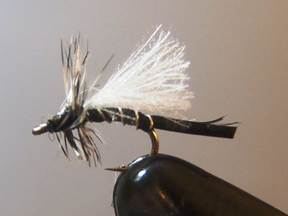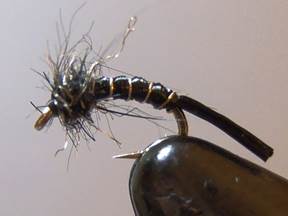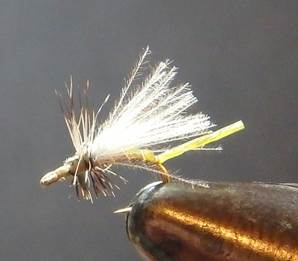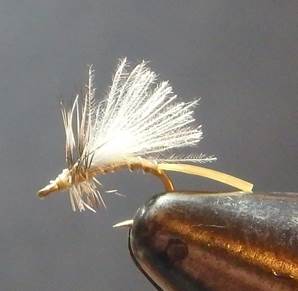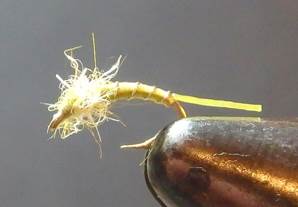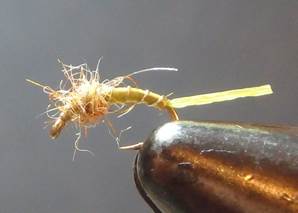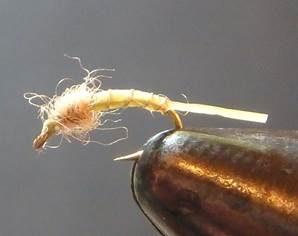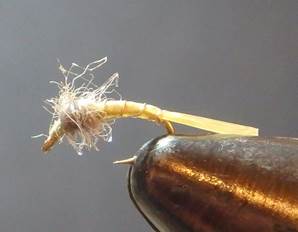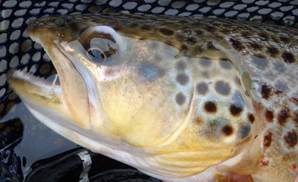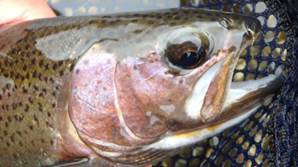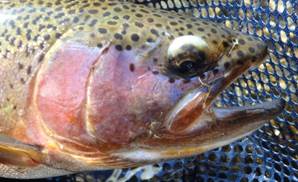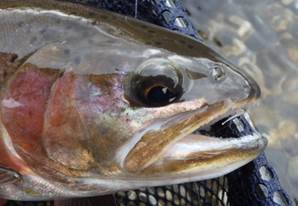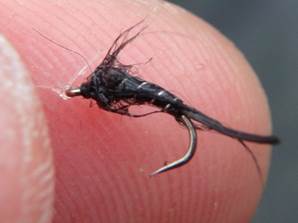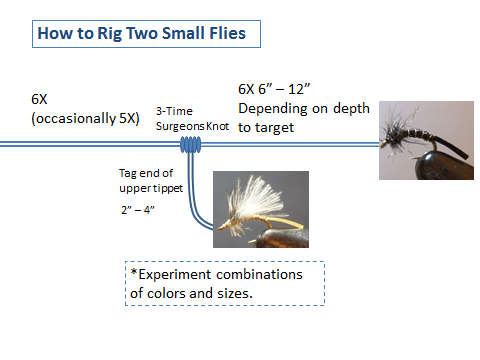RISE ABOVE, BITE BELOW (part 2)
| Sysadmin Note |
|---|
| Part 1 can be found here |
Introduction:
Originally I meant to write one piece but I figured the following materials would be discussed better in the separate chapter.
Original Go-To Patterns:
These are two out of many "tested at the creek" and "approved by trout" flies. The midge APE is a surface dry-fly pattern and APE stands for Adults, Pupa, and Emerger. Indeed this can imitate either one or anything between of three stages at the same time. Pupaerger is the made-up term of Pupa + Emerger. I can't emphasize enough how effective this pattern is on midging trout. Sooner or later, Pupaerger will be approved as an official English word and be added to the Oxford Dictionary! I have been using both in black, as black is the most common midge color on the Livingston's spring creek and many other waters.
|
|
Hook: Emerger hook (Dai-Riki 125) #20-24 Thread: Veevus 12/0 or 16/0, black. It also forms a thread under-body. Ribbing: Silver fine wire Tail & Upper Body: Life Flex (or alike), black Wing: CDC white or natural dun Hackle: Grizzly |
Hook: MFC 7048 Light Wire Scud Hook #20-24 Thread: Veevus 12/0 or 16/0, black Ribbing: Silver fine wire Tail & Abdomen: Life Flex (or alike), black,wrapped forward Thorax: Black dubbing, preferably shaggy & sparkly |
Midge APE – New Colors:
When my mentor and I came upon each other while fishing he offered me another bit of sage advice. He suggested that I tie and expand my go-to patterns in gray and pale olive. We do observe midges in those light colors at creeks. Though I have used cream patterns every now and then, this time I seriously considered expanding and experimenting with new colors. At my tying bench I happened to find some old Span-Flex (practically same as Life Flex used above) that someone gave to me a while ago. It was exactly the colors I needed!!
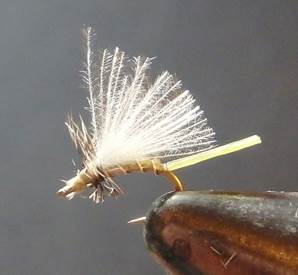 |
|
Gray |
Pale olive |
|
Hook: Emerger hook (Dai-Riki 125) #20-24 Thread: Veevus 12/0 or 16/0. Color to match the body. It also forms a thread under-body. Ribbing: Silver fine wire Tail & Upper Body: Life Flex (or alike), black Wing: CDC white or natural dun Hackle: Grizzly |
Cream |
Pupaerger – New Colors:
For new colors of Pupaerger, Span-Flex used for Midge APE above was easily incorporated. However, colors of dubbing for the thorax were hard to assign as every color I thought of looked good. Indeed any combination worked! Below, I will show each of gray, cream, and pale olive abdomens. Then I just list the successful colors for dubbing. Go back to the first chapter and observe color(s) of pupae I collected. So I suggest you adapt this pattern to match midges for the waters you fish.
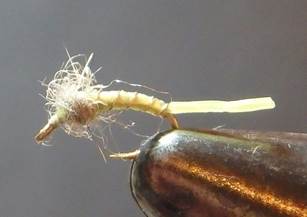 |
Shown is Dave Whitlock SLF Dub Sowbug Gray. NOTE: To simplify my own box organization, a gray version is all composed with gray materials. |
Gray abdomen & gray thorax |
|
|
|
Pale olive abdomen & thorax |
Pale olive abdomen & tan thorax |
|
|
Cream abdomen & dark pink thorax |
Cream abdomen & gray thorax |
|
|
NOTE: During the development stage for pale olive and cream abdomens, all these four thorax colors seemed to match and were deadly. So there are 2 (colors of abdomen) x 4 (colors of thorax) = 8 color combinations. Furthermore, I tied them in sizes 20, 22, and 24. That is 24 size-color combinations!! Finally I tested them all at the creek and caught fish successfully!! Then don't forget I also had to experiment a gray-gray version in 3 hook sizes!! How many patterns I have tested would that be?
Here's gallery of iron-clad proof!! (Both patterns and all colors)
|
|
|
|
|
|
Rigging:
This two-fly rigging has been proven to work, especially when fishing with small flies (midges and Baetis mayflies). It is hard (impossible for some folks) to attach a dropper-tippet on the bend of tiny flies. Even if it's done, it seems to narrow the gap of small hooks. Don't assume the dry-fly in this rig primarily serves as an indicator for the dropper. I have had many bites on dry-flies and successfully netted trout.
|
If you can master the art of "subsurface match-the-hatch" successfully, you will be smirking with your catches behind the back of many other dry-fly enthusiasts who are frustrating themselves by their own limitations and unwillingness to change their views. Also I can guarantee you that, when the situation calls for you being a dry-fly fisher, will be as successful and competitive as your neighborhood dry-fly enthusiasts!!
Satoshi Yamamoto, https://leftyangler.blogspot.com, is a guide and a fly-dresser based in Livingston, MT.
Archive of the Eye of the guide

